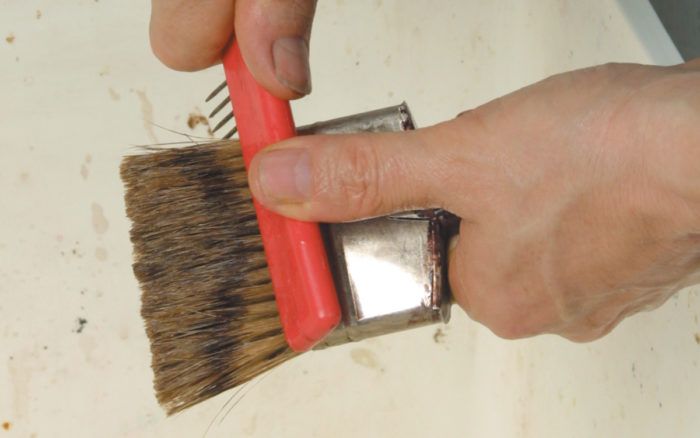The Care and Feeding of Brushes
Follow a pro's advice for brush cleaning and maintenance.

A collection of brushes can represent a serious investment, so it’s wise to take good care of them. After using a brush, I follow a diligent cleaning and maintenance program to remove finishing residue and maintain the brush’s profile.
The cleaning process actually begins before the finish is even applied: Before dipping the brush in the finish, “condition” it by dipping it into the cleanup solvent for the finish. This will make it much easier to clean after use. When you’re done applying the finish, remove the excess finish from the brush using a clean rag, then dunk the brush into the cleanup solvent and swish it around. Wipe the solvent off, then lather it up with a grease-cutting dishwashing detergent. Swish the bristles around in the palm of your hand, bending them back and forth to work in the detergent, particularly near the brush ferrule (A).
Rinse the brush with water until it no longer feels slimy, then rinse it again and spin the excess water out by twirling the handle between your palms (B). Comb the bristles straight with a brush comb (C). Finish up by wrapping a paper towel around the edges of the brush, then over the top (D). Hang the brush up or put it in a drawer for storage.
Reviving a Hardened Brush
If you find that one of your expensive brushes is rock-hard from improper or overlooked cleaning, you can usually bring it back to life. First, soak the brush in an NMP (N-Methyl Pyrrolidone)-based stripper like Citristrip.
NMP is gentler on bristles than methylene chloride-based stripper. Leave the brush in the stripper for about four hours and then work the stripper into the bristles with gloved hands (A). Hold the brush over the edge of a bench and use a stiff wire brush to clean out the softened finish. Bear down hard on the bristles, particularly near the ferrule (B). Clean away the stripper/finish residue by washing it well in warm water and grease-cutting dishwashing detergent (C). Use a brush comb to straighten out the bristles and remove any last hunks of finish. Finish up by rinsing with plenty of warm water. Wrap the brush for storage as shown in the previous section on brush care.
Fine Woodworking Recommended Products

Dividers

Tite-Mark Marking Gauge

Blackwing Pencils














Comments
I mostly do varnishing, where every little spec of dust or dirt will detract from the quality of work. So - cleaning a brush before every use is good practice and pays off. Amplifying the step you mention (right at "dipping into cleanup solvent") is important for removing any foreign particles from your brush. For that, swish the brush thoroughly in some clean mineral spirits, then carefully spin out until the brush is nearly dry, using a mechanical paint spinner. Any good paint store will have these spinners for sale, and it's important to have one.
I know a few experienced boat varnishers who have used the same brushes almost every work day for years, and still turn out a dead perfect finish every time, enhanced by practicing careful and consistent brush maintenance.
Log in or create an account to post a comment.
Sign up Log in